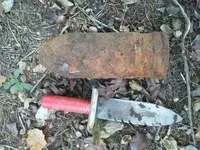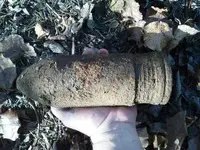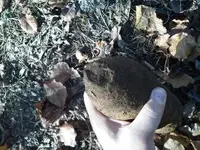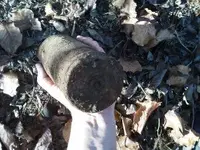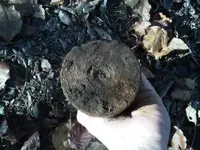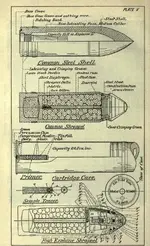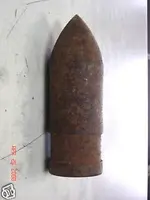You are using an out of date browser. It may not display this or other websites correctly.
You should upgrade or use an alternative browser.
You should upgrade or use an alternative browser.
Unidentified Artillery Shell
- Thread starter BRelic1
- Start date
TheCannonballGuy
Gold Member
- Joined
- Feb 24, 2006
- Messages
- 6,606
- Reaction score
- 13,450
- Golden Thread
- 0
- Location
- Occupied CSA (Richmond VA)
- Detector(s) used
- White's 6000, Nautilus DMC-1, Minelab
- Primary Interest:
- Relic Hunting
Your are correct that it is a 20th Century artillery projectile. It appears to be an armor-piercing projectile, from the WW1 to WW2 era. Without having super-precise measurement of its body diameter (such as, 2.96-inches), I cannot be more specific about the time-period than that.
I'll attach a photo at the end of this post which shows an Armor-Piercing 75mm projectile reported to be from World War 2 (but it may be WW1 era). Like yours, it had a WIDE copperbrass band about 1/2-inch above its base. The band is missing, indicating the projectile was fired and the copperbrass band tore off the projectile burrowed into the ground (or some other hard surface).
Some armor-piercing projectiles are Solid-Shot (meaning, not a hollow explosive body), and some have a solid "nose" with an impact-detonation fuse in the projectile's flat base. Your photos show the projectile in uncleaned condition, so I cannot tell for certain whether your projectile is a base-fuzed explosive one or a Solid-Shot. It LOOKS like it has a small hole in the center of its base, which is an indication that it is a Solid-Shot with a hole for the "tracer" chemical in its base. But that type usually does not have a groove encircling the hole. Please gently remove the dirt and rust-encrustation from that hole and groove. Then tell me the groove's diameter, the hole's diameter, AND how deep the hole is. A closeup photo of it after you clean out the groove and the hole would help give certainty in identifying the projectile.
Here is a diagram from a 1915 US Army document, showing a base-fuzed Armor-Piercing 3"-caliber shell at the top of the diagram.
Note that the diameter of the fuze in the 3-inch shell's base is about 1.25-inches. Most 20th Century artillery fuzes are brass, but a few are steel. At the moment, I think your projectile is just a Solid-Shot with a tracer hole in the base... but the groove around the hole makes me want to be sure it is not a base-fuzed explosive shell.
I'll attach a photo at the end of this post which shows an Armor-Piercing 75mm projectile reported to be from World War 2 (but it may be WW1 era). Like yours, it had a WIDE copperbrass band about 1/2-inch above its base. The band is missing, indicating the projectile was fired and the copperbrass band tore off the projectile burrowed into the ground (or some other hard surface).
Some armor-piercing projectiles are Solid-Shot (meaning, not a hollow explosive body), and some have a solid "nose" with an impact-detonation fuse in the projectile's flat base. Your photos show the projectile in uncleaned condition, so I cannot tell for certain whether your projectile is a base-fuzed explosive one or a Solid-Shot. It LOOKS like it has a small hole in the center of its base, which is an indication that it is a Solid-Shot with a hole for the "tracer" chemical in its base. But that type usually does not have a groove encircling the hole. Please gently remove the dirt and rust-encrustation from that hole and groove. Then tell me the groove's diameter, the hole's diameter, AND how deep the hole is. A closeup photo of it after you clean out the groove and the hole would help give certainty in identifying the projectile.
Here is a diagram from a 1915 US Army document, showing a base-fuzed Armor-Piercing 3"-caliber shell at the top of the diagram.
Note that the diameter of the fuze in the 3-inch shell's base is about 1.25-inches. Most 20th Century artillery fuzes are brass, but a few are steel. At the moment, I think your projectile is just a Solid-Shot with a tracer hole in the base... but the groove around the hole makes me want to be sure it is not a base-fuzed explosive shell.
Attachments
Last edited:
Upvote
0
Beeps in my sleep
Hero Member
- Joined
- Sep 6, 2013
- Messages
- 760
- Reaction score
- 1,004
- Golden Thread
- 0
- Location
- Shippensburg, Pennsylvania
- Detector(s) used
- Whites 6000, Fisher F2, Garrett AT Pro, XP Deus
- Primary Interest:
- All Treasure Hunting
Be careful with that.....Don't need another WW1 WW2 Casualty in 2014 from another bomb. Cool find though  Where did you find that happy little life ender?
Where did you find that happy little life ender?
 Where did you find that happy little life ender?
Where did you find that happy little life ender?
Upvote
0
markp
Sr. Member
- Joined
- Dec 3, 2013
- Messages
- 388
- Reaction score
- 115
- Golden Thread
- 0
- Location
- Peytona,WV
- Detector(s) used
- White dfx, and Garrett at pro
- Primary Interest:
- Relic Hunting
nice find
Upvote
0
BRelic1
Tenderfoot
- Joined
- Feb 11, 2014
- Messages
- 5
- Reaction score
- 2
- Golden Thread
- 0
- Primary Interest:
- All Treasure Hunting
- #5
Thread Owner
Wow! You sure know your stuff! Thank you so much for the great detail in your reply. The one in the picture you sent looks identical. I am attaching photos with measurements. It looks to be 9 1/2 inches long, Base Width 3 1/2 inches, and the hole in the base measures 1 inch across. Sorry about not including a picture across the base where the hole is located. No worries about safety- I buried the thing about 3 feet down so that I could retrieve it if it's deemed safe. However, if you still cannot help me determine if it has a fuse, I can go back and dig it up and get more precise measurements if needed. I appreciate you very much!
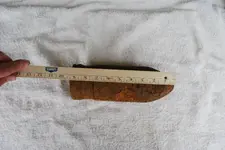
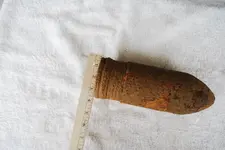
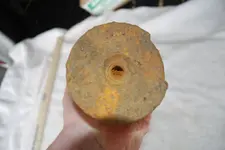




Upvote
0
BRelic1
Tenderfoot
- Joined
- Feb 11, 2014
- Messages
- 5
- Reaction score
- 2
- Golden Thread
- 0
- Primary Interest:
- All Treasure Hunting
- #6
Thread Owner
I have it buried for now until I can figure out if it is safe. Thanks for your reply and I will be safe. Found it of all places- Ringgold, Georgia. Go figure?
Upvote
0
TheCannonballGuy
Gold Member
- Joined
- Feb 24, 2006
- Messages
- 6,606
- Reaction score
- 13,450
- Golden Thread
- 0
- Location
- Occupied CSA (Richmond VA)
- Detector(s) used
- White's 6000, Nautilus DMC-1, Minelab
- Primary Interest:
- Relic Hunting
Thank you for making and posting the better photos. They show it is a World War One era artillery projectile, not World War Two (or later) projectile. The "nose" of WW2-&-later Armor-Piercing projectiles is more sharply pointed than your projectile's "nose."
You say its diameter is (approximately) 3.5-inches, which translates to 88 millimeters, and that body-diameter measurement indicates it is a 90mm-caliber projectile.
The hole and circular groove in projectile's base still aren't clean enough for me to be 100%-certain whether it is a Solid-Shot or an explosive shell which is base-fuzed. However, if it is base-fuzed, the fairly deep hole indicates the fuze's "guts" are missing, which means the fuze is no longer capable of functioning.
My specialty-area is pre-1880s projectiles, not 20th Century ones. The simplest solution for getting 100%-certain ID of your 20th Century projectile is for you to join the Inert Ordnance Collectors internet-forum (which is similar to the TreasureNet forum), and post your photos and measurements of the projectile in the Projectiles category there. To do that, you'll need to register as a member, just like you did here at TreasureNet.
Inert Ordnance Collectors
At that website, the Projectiles category is the third category in the list of categories.
You say its diameter is (approximately) 3.5-inches, which translates to 88 millimeters, and that body-diameter measurement indicates it is a 90mm-caliber projectile.
The hole and circular groove in projectile's base still aren't clean enough for me to be 100%-certain whether it is a Solid-Shot or an explosive shell which is base-fuzed. However, if it is base-fuzed, the fairly deep hole indicates the fuze's "guts" are missing, which means the fuze is no longer capable of functioning.
My specialty-area is pre-1880s projectiles, not 20th Century ones. The simplest solution for getting 100%-certain ID of your 20th Century projectile is for you to join the Inert Ordnance Collectors internet-forum (which is similar to the TreasureNet forum), and post your photos and measurements of the projectile in the Projectiles category there. To do that, you'll need to register as a member, just like you did here at TreasureNet.
Inert Ordnance Collectors
At that website, the Projectiles category is the third category in the list of categories.
Upvote
0
BRelic1
Tenderfoot
- Joined
- Feb 11, 2014
- Messages
- 5
- Reaction score
- 2
- Golden Thread
- 0
- Primary Interest:
- All Treasure Hunting
- #9
Thread Owner
Thank you for taking time to look the photos over and give me some guidance in what to do. Honestly, I am just too afraid to dig any deeper into the fuse area, don't want to be a late WW1 casualty. I will start up a membership with the Inert Ordnance Collectors and let you know what I find out. I cannot thank you enough for all your help. Happy Digging and Keep up the great work on being a one of a kind resource for us all.
Upvote
0
Similar threads
- Solved
- Replies
- 6
- Views
- 262
- Replies
- 0
- Views
- 160
Users who are viewing this thread
Total: 1 (members: 0, guests: 1)

